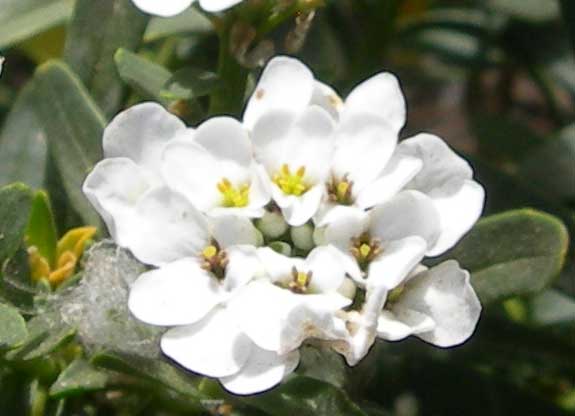
Iberis sempervirens , Photo: nps.gov
Classification System: APG IV
Superregnum: Eukaryota
Regnum: Plantae
Cladus: Angiosperms
Cladus: Eudicots
Cladus: Core eudicots
Cladus: Rosids
Cladus: Eurosids II
Ordo: Brassicales
Familia: Brassicaceae
Tribus: Iberideae
Genus: Iberis
Sectio: I. sect. Iberidium
Subsectio: I. subsect. Suffruticulosae
Species: Iberis sempervirens
Name
Iberis sempervirens L. (1753)
Synonyms
Aethionema longistylum Post
Iberis garrexiana All.
Iberis serrulata Vis.
References
Linnaeus, C. 1753. Species Plantarum 2: 648.
Links
Koch, M.A. et al. 2019. Iberis sempervirens in BrassiBase Tools and biological resources to study characters and traits in the Brassicaceae. Published on the internet. Accessed: 2019 Jun 05.
International Plant Names Index. 2019. Iberis sempervirens. Published online. Accessed: Jun 05 2019.
The Plant List 2013. Iberis sempervirens in The Plant List Version 1.1. Published on the internet. Accessed: 2019 Jun 05.
Tropicos.org 2019. Iberis sempervirens. Missouri Botanical Garden. Published on the internet. Accessed: 2019 Jun 05.
Castroviejo, S. et al. (eds.) 2014. Iberis sempervirens in Flora Ibérica. Plantas vasculares de la Península Ibérica, e Islas Baleares. Published on the internet. Accessed: 2014 Aug 02. Reference page.
USDA, ARS, Germplasm Resources Information Network. Iberis sempervirens in the Germplasm Resources Information Network (GRIN), U.S. Department of Agriculture Agricultural Research Service. Accessed: 09-Oct-10.
Vernacular names
čeština: štěničník vždyzelený, iberka vždyzelená
dansk: Almindelig Sløjfeblomst
Deutsch: Immergrüne Schleifenblume
English: evergreen candytuft, perennial candytuft
español: canasta de plata
suomi: Talvisaippo
français: ibéris toujours vert
hornjoserbsce: Trajna seklička
magyar: örökzöld tatárvirág
polski: ubiorek wiecznie zielony
русский: иберис вечнозелёный
slovenčina: iberka vždyzelená
svenska: vinteriberis
українська: іберійка вічнозелена
Iberis sempervirens, the evergreen candytuft[1] or perennial candytuft,[2] is a species of flowering plant in the family Brassicaceae, native to southern Europe. The species is often used as an ornamental garden shrub because of its decorative flowers. Iberis is so named because many members of the genus come from the Iberian Peninsula in south west Europe. Sempervirens means "always green", referring to the evergreen foliage.[3]
Range
The natural range is in Europe in Spain, France, Italy, the British Isles, Romania and the Balkan Peninsula. In Africa, it is found in Morocco and Algeria. In Asia, it is present in Syria. It is naturalised in North and South America. It grows in steppes and dry forests on moderately dry to fresh, slightly acidic to alkaline, sandy-loamy to loamy, nutrient-rich soils in sunny to light shady locations. The species is heat loving and frost hardy.[4]
Description
It is a spreading subshrub growing to 30 cm (12 in) high by 40 cm (16 in) broad. As an ornamental plant it is a spring-blooming favourite, often seen cascading over rocks and walls, or used as groundcover. The glossy, evergreen foliage forms a billowing mound, with many fragrant, pure white flowers in tight clusters [5] for several weeks during spring and early summer. The leaf blade of the leaves is leathery, 25–75 mm or 1–3 in (and rarely 125 mm or 5 in) long, 2 to 5 millimetres wide, oblong spatulate to lanceolate, obtuse with a pointed base. The fruits are roundish to broad ovate, 6 to 8 millimetres long and 5 to 6 millimetres wide. The seeds are narrowly winged and 2 to 3 millimetres long.[6]
Cultivation
When grown in a garden it may require light pruning right after blooming, but otherwise plants can be left alone in fall and early spring. It is drought-tolerant once established. It prefers a well-drained site, so heavy clay soils that stay wet in winter should be avoided. It is not easily divided.[7] Iberis sempervirens survives in USDA hardiness zones 3–9 with mean annual minimum temperatures of −23 to −21 °C (−10 to −5 °F).[8]
It is hardy in most parts of the UK, surviving temperatures down to −15 °C (5 °F). Vernalization (a period of cold weather) is required for flower initiation.[9] At least 8–10 weeks are needed at an average temperature of 5 °C (40 °F).[10]
The cultivar 'Snowflake'[11] has gained the Royal Horticultural Society's Award of Garden Merit.[12]
References
"Iberis sempervirens". Natural Resources Conservation Service PLANTS Database. USDA. Retrieved 22 January 2016.
BSBI List 2007 (xls). Botanical Society of Britain and Ireland. Archived from the original (xls) on 2015-06-26. Retrieved 2014-10-17.
Brassicaceae [also known as Cruciferae] - Mustard Family, archived from the original on May 12, 2011
Jost Fitschen: Gehölzflora. 12., überarbeitete und ergänzte Auflage. Quelle & Meyer, Wiebelsheim 2007, ISBN 3-494-01422-1, S. 534.
RHS A-Z encyclopedia of garden plants. United Kingdom: Dorling Kindersley. 2008. p. 1136. ISBN 978-1405332965.
Andreas Roloff, Andreas Bärtels: Flora der Gehölze. Bestimmung, Eigenschaften und Verwendung. Mit einem Winterschlüssel von Bernd Schulz. 3., korrigierte Auflage. Eugen Ulmer, Stuttgart (Hohenheim) 2008, ISBN 978-3-8001-5614-6, S. 346.
"Iberis sempervirens". Missouri Botanical Garden. Retrieved 12 October 2017.
"Iberis sempervirens". plants.ces.ncsu.edu. Retrieved 2017-01-07.
"Vernalization: Life In The Cold" (PDF). Greenhouse Grower. January 2006. Retrieved 2017-01-06.
"Whiteout Iberis" (PDF). Ball Horticultural Company. 2013. Retrieved 2017-01-06.
"RHS Plant Selector". Royal Horticultural Society. Retrieved 28 March 2020.
"AGM Plants - Ornamental" (PDF). Royal Horticultural Society. July 2017. p. 52. Retrieved 3 March 2018.
Retrieved from "http://en.wikipedia.org/"
All text is available under the terms of the GNU Free Documentation License

